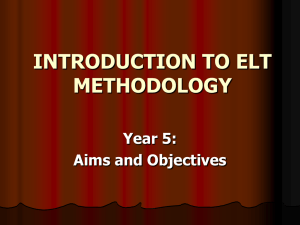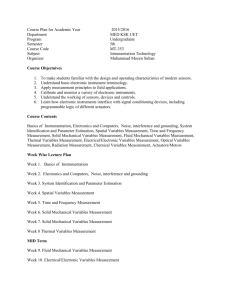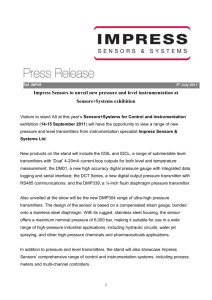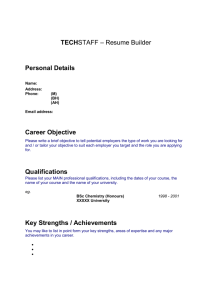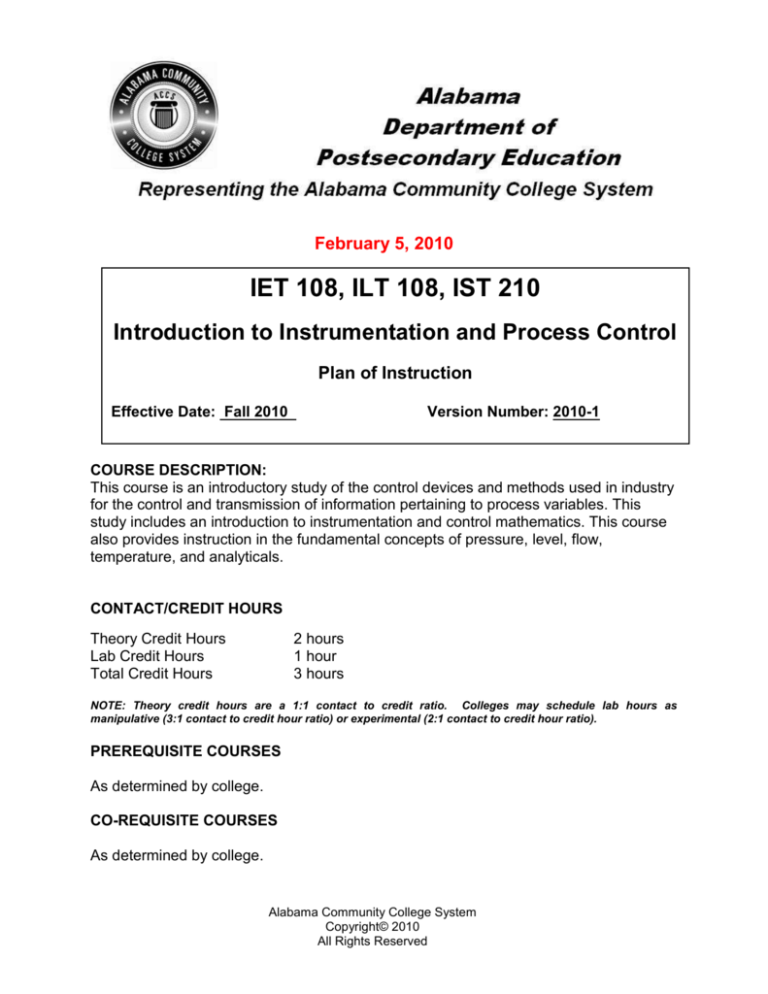
February 5, 2010
IET 108, ILT 108, IST 210
Introduction to Instrumentation and Process Control
Plan of Instruction
Effective Date: Fall 2010
Version Number: 2010-1
COURSE DESCRIPTION:
This course is an introductory study of the control devices and methods used in industry
for the control and transmission of information pertaining to process variables. This
study includes an introduction to instrumentation and control mathematics. This course
also provides instruction in the fundamental concepts of pressure, level, flow,
temperature, and analyticals.
CONTACT/CREDIT HOURS
Theory Credit Hours
Lab Credit Hours
Total Credit Hours
2 hours
1 hour
3 hours
NOTE: Theory credit hours are a 1:1 contact to credit ratio. Colleges may schedule lab hours as
manipulative (3:1 contact to credit hour ratio) or experimental (2:1 contact to credit hour ratio).
PREREQUISITE COURSES
As determined by college.
CO-REQUISITE COURSES
As determined by college.
Alabama Community College System
Copyright© 2010
All Rights Reserved
Introduction to Instrumentation and Process Control
IET 108, ILT 108, IST 210
PROFESSIONAL COMPETENCIES
Comprehend the basic principles of process control
Comprehend pressure in a process control loop.
Comprehend temperature in a process control loop.
Comprehend level measurement in a process control loop.
Comprehend flow measurement in a process control loop.
Comprehend analytical measurements in process controls.
Read and interpret block diagrams and instrument drawings.
INSTRUCTIONAL GOALS
Cognitive – Comprehend principles and concepts related to process control and
instrumentation.
Psychomotor – Apply principles of process control and instrumentation.
Affective – Value the importance of adhering to policy and procedures related to
process control and instrumentation.
STUDENT OBJECTIVES
Condition Statement: Unless otherwise indicated, evaluation of student’s attainment
of objectives is based on knowledge gained from this course. Specifications may be in
the form of, but not limited to, cognitive skills diagnostic instruments, manufacturer’s
specifications, technical orders, regulations, national and state codes, certification
agencies, locally developed lab/clinical assignments, or any combination of
specifications.
ACCS Copyright© 2010
All Rights Reserved
2
Introduction to Instrumentation and Process Control
IET 108, ILT 108, IST 210
STUDENT LEARNING OUTCOMES
MODULE A – INTRODUCTION TO PROCESS CONTROL
MODULE DESCRIPTION – The purpose of this module is to teach the students to
comprehend the basic principles of process control. Topics include safety, terms,
concepts, and functions of elements of process control.
PROFESSIONAL COMPETENCIES
PERFORMANCE OBJECTIVES
A1.0 Comprehend the basic
A1.1 This competency will be
principles of process control.
measured cognitively.
LEARNING OBJECTIVES
KSA
2
KSA
A1.1.1
A1.1.2
A1.1.3
A1.1.4
A1.1.5
A1.1.6
A1.1.7
A1.1.8
A1.1.9
Define various terms associated with process control.
Explain the concept of the control loop.
Describe the function of a sensor.
Describe the function of a transmitter
Describe the function of a controller.
Describe the function of a recorder
Describe the function of a transducer
Describe the function of a final control element
Describe the basic safety rules and practices for industrial process
control.
MODULE A OUTLINE:
o Safety
Pressurized piping
Steam
Chemicals (toxics and acidics)
Electrical safety
Lock-out/tag-out
o Terms
Process variables
Set Point
Range
Lower range value
Upper range value
Span
Process control loop
Etc
1
2
2
2
2
2
2
2
2
ACCS Copyright© 2010
All Rights Reserved
3
Introduction to Instrumentation and Process Control
IET 108, ILT 108, IST 210
MODULE B – PRESSURE MEASUREMENT
MODULE DESCRIPTION – The purpose of this module is for the student to comprehend
pressure in a process control loop. Topics include pressure definition, conversions,
pressure indicators, pressure sensors, and pressure transmitters.
PROFESSIONAL COMPETENCIES
PERFORMANCE OBJECTIVES
KSA
B1.0 Comprehend pressure in a
B1.1 This competency is measured
3
process control loop.
cognitively.
LEARNING OBJECTIVES
B1.1.1
B1.1.2
B1.1.3
B1.1.4
B1.1.5
Define pressure as force over area.
Convert different units used in pressure measurement.
Identify and describe the operation of pressure indicators.
Identify and describe the operation of a pressure sensors.
Identify and describe the operation of pressure transmitters.
KSA
1
2
3
3
3
MODULE B OUTLINE:
Pressure defined
Pressure converted
Pressure sensors
o Bourdon tubes
o Bellows
o Capacitive and inductive pressure sensors
Pressure indicators
o Manometers
o Gauges
Pressure transmitters
o Electrical
o Pneumatic
MODULE C – TEMPERATURE MEASUREMENT
MODULE DESCRIPTION – The purpose of this module is for the student to comprehend
temperature in a process control loop. Topics include temperature measurement,
conversions, temperature indicators, temperature sensors, and temperature transmitters.
PROFESSIONAL COMPETENCIES
PERFORMANCE OBJECTIVES
KSA
C1.0 Comprehend temperature in a
C1.1 This competency is measured
3
process control loop.
cognitively.
LEARNING OBJECTIVES
C1.1.1
C1.1.2
C1.1.3
C1.1.4
C1.1.5
Define temperature as a measurement of kinetic energy.
Define the concept and measurement of latent heat.
Convert different units used in temperature measurement.
Identify and describe the operation of temperature indicators.
Identify and describe the operation of a temperature sensors.
ACCS Copyright© 2010
All Rights Reserved
KSA
1
2
2
3
3
4
Introduction to Instrumentation and Process Control
IET 108, ILT 108, IST 210
C1.1.6 Identify and describe the operation of temperature transmitters.
3
MODULE C OUTLINE:
Temperature defined
Temperature converted
Temperature sensors
o Bimetal
o Thermometer
o Resistance Thermal Device (RTD)
o Thermocouple
o Thermistor
o Filled system
Temperature indicators
o Temperature Gauges
o Thermistats
o Thermometer
Temperature transmitters
o Electrical
o Pneumatic
MODULE D – LEVEL MEASUREMENT
MODULE DESCRIPTION – The purpose of this module is for the student to comprehend
level measurement in a process control loop. Topics include defining levels, level
indicators, level sensors, and level transmitters.
PROFESSIONAL COMPETENCIES
PERFORMANCE OBJECTIVES
KSA
D1.0 Comprehend level
D1.1 This competency is measured
3
measurement in a process
cognitively.
control loop.
LEARNING OBJECTIVES
D1.1.1
D1.1.2
D1.1.3
D1.1.4
D1.1.5
Define fluid level measurement in process control systems.
Differentiate between depth and height used in level measurement.
Identify and describe the operation of level indicators.
Identify and describe the operation of a level sensors.
Identify and describe the operation of level transmitters.
KSA
1
3
3
3
3
MODULE D OUTLINE:
Level defined
Level measured using pressure
Level sensors
o Float switch
o Sight glass
o Tape gauge
o Displacer
o Nuclear devices
ACCS Copyright© 2010
All Rights Reserved
5
Introduction to Instrumentation and Process Control
IET 108, ILT 108, IST 210
o Radar and sonar devices
o Capacitance
Level indicators
o Sight glass
Level transmitters
o Electrical
o Pneumatic
o Various uses of Differential Pressure (DP) cells
MODULE E – FLOW MEASUREMENT
MODULE DESCRIPTION – The purpose of this module is for the student to comprehend
flow measurement in a process control loop. Topics include fluid flow measurement
definition, flow indicators, flow sensors, and flow transmitters.
PROFESSIONAL COMPETENCIES
PERFORMANCE OBJECTIVES
KSA
E1.0 Comprehend flow
E1.1 This competency is measured
3
measurement in a process
cognitively.
control loop.
LEARNING OBJECTIVES
E1.1.1
E1.1.2
E1.1.3
E1.1.4
E1.1.5
Define fluid flow measurement in process control systems.
Differentiate between laminar and turbulent flow measurement.
Identify and describe the operation of flow indicators.
Identify and describe the operation of a flow sensors.
Identify and describe the operation of flow transmitters.
KSA
1
3
3
3
3
MODULE E OUTLINE:
Flow defined
Flow measured using differential pressure
Flow sensors
o Flow switch
o Sight glass
o Turbine meter
o Rotometer
o Nuclear devices
o Orifice plate
o Venturi tube
o Flow nozzle
o Pitot tube
o Electromagnetic meter (Magmeter)
o Mass flow meter
Flow indicators
o Sight glass
o Rotometer
Flow transmitters
ACCS Copyright© 2010
All Rights Reserved
6
Introduction to Instrumentation and Process Control
IET 108, ILT 108, IST 210
o Electrical
o Pneumatic
o Various uses of Differential Pressure (DP) cells
MODULE F – ANALYTICALS
MODULE DESCRIPTION – The purpose of this module is for the student to comprehend
analytical measurements in process controls. Topics include analytical measurements for
environmental, economic, and production purposes. Incentives for analytical
measurement will also be looked at as well as analytical indicators, sensors, and
transmitters.
PROFESSIONAL COMPETENCIES
PERFORMANCE OBJECTIVES
KSA
F1.0 Comprehend analytical
F1.1 This competency is measured
3
measurements in process
cognitively.
controls.
LEARNING OBJECTIVES
F1.1.1 Define various analytical measurements.
F1.1.2 Differentiate between environmental, economic, and production
incentives for analytical measurement.
F1.1.3 Identify and describe the uses of analytical indicators.
F1.1.4 Identify and describe the uses of analytical sensors.
F1.1.5 Identify and describe the uses of analytical transmitters.
KSA
1
3
3
3
3
MODULE F OUTLINE:
Analytical measurements for environmental purposes
Analytical measurements for economic purposes
Analytical measurements for production purposes
Analytical sensors
o Combustion
CO2
O2
CO
CH4
o Chemical properties
pH
ORP
Conductivity
o Optical measurement
Color
Turbidity
Opacity
Chromatography
Spectrometry
ACCS Copyright© 2010
All Rights Reserved
7
Introduction to Instrumentation and Process Control
IET 108, ILT 108, IST 210
Mass spectrometry
o Carbon Analyzers
o Monitors
Personnel
Area
Unit or plant boundaries
Analytical transmitters
MODULE G – PROCESS INSTRUMENT DIAGRAMS AND DRAWINGS
MODULE DESCRIPTION – The purpose of this module is to teach the students to read
and interpret block diagrams and instrument drawings. Topics include block diagrams,
instrument tag fundamentals, interpreting tags, P & ID drawing, and loop sheet diagram
drawing.
PROFESSIONAL COMPETENCIES
PERFORMANCE OBJECTIVES
KSA
G1.0 Read and interpret block
G1.1 Draw a block diagram of a
2
diagrams and instrument
process system.
drawings.
G1.2 Identify type and location of
2
device by tag.
G1.3 Draw a Piping and Instrumentation
Diagram
G1.4 Draw a Loop Sheet Diagram
LEARNING OBJECTIVES
G1.1.1
G1.1.2
G1.1.3
G1.1.4
G1.1.5
G1.1.6
G1.1.7
G1.2.1
2
2
KSA
Explain the function of a block diagram.
Explain the types of lines in a block diagram.
Explain instrument tag numbers.
Explain the format of the instrument balloon.
Identify the various instrumentation symbols.
Explain the function of a Piping and Instrumentation drawing (P&ID).
Explain the function of a loop sheet.
Describe the information contained on an instrument tag and how it is
used.
G1.2.2 Explain the different types of tags and their meanings.
MODULE G OUTLINE:
Block diagrams
o Function
o Lines
o Balloons
o Symbols
2
2
2
2
2
2
2
2
ACCS Copyright© 2010
All Rights Reserved
8
2
Introduction to Instrumentation and Process Control
IET 108, ILT 108, IST 210
Instrument tag fundamentals
o Types of instrument functions
o Identify loop numbers
o Location of devices
P & ID
o Rough sketch
o Equipment list
o Final draft
Loop sheet
LEARNING OUTCOMES TABLE OF SPECIFICATIONS
The table below identifies the percentage of learning objectives for each module.
Instructors should develop sufficient numbers of test items at the appropriate
level of evaluation.
Limited
Knowledge and
Proficiency
Module A
Module B
Module C
Module D
Module E
Module F
Module G
ACCS Copyright© 2010
All Rights Reserved
1
12%
20%
17%
20%
20%
20%
Moderate
Knowledge
and
Proficiency
2
88%
20%
33%
Advanced
Knowledge
and
Proficiency
3
Superior
Knowledge
and
Proficiency
4
60%
50%
80%
80%
80%
100%
9
Introduction to Instrumentation and Process Control
Indicator
1
2
3
4
IET 108, ILT 108, IST 210
Learner’s Knowledge, Skills and Abilities
Key Terms
Description
Identifies basic facts and terms about the subject or
competency.
Limited
Knowledge Performs simple tasks associated with the
and
competency. Needs to be told or shown how to do
Proficiency
most tasks.
Requires close supervision.
Identifies relationship of basic facts and states
general principles and can determine step-by-step
Moderate
procedures for doing the competency.
Knowledge
and
Performs most parts of the competency. Needs help
Proficiency
only on hardest parts.
Requires limited supervision.
Analyzes facts and principles and draws conclusions
about the subject to include why and when the
Advanced
competency must be done and why each step is
Knowledge
needed. Can predict outcomes.
and
Performs all parts of the competency. Needs only a
Proficiency
spot check of completed work.
Requires little or no direct supervision.
Can evaluate conditions and make appropriate
Superior
decisions as related to resolving problems.
Knowledge
Performs competency quickly and accurately with no
and
direct supervision and is able to instruct and
Proficiency
supervise others.
ACCS Copyright© 2010
All Rights Reserved
10


